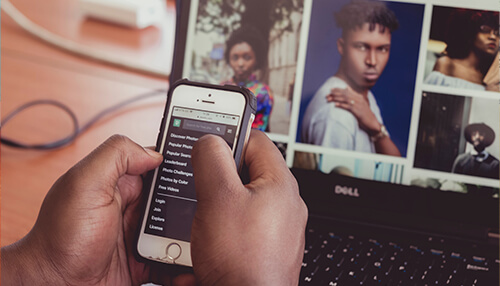Looking for a way to reverse image search on your iPhone?
It’s easy! Just follow these steps:
- Open the Photos app and go to Albums
- Tap on the album you want to search
- Tap on an image, then tap Share > Copy Image Address
- Paste that URL into Google Images or TinEye (or another reverse image search service) to get results
What is a reverse search image?
Reverse image search is a way to find out where an image came from.
It’s pretty simple. You just upload a picture and the site will tell you where else it’s been used. It can help you find out what website has used your image without permission, or if someone has stolen your photo and put it on their website without crediting you. It’s a lot like using a Google search, but instead of searching for words, you’re searching for images. Reverse image search uses a database of images to help you find the source of an image that may have been used without permission.
Why do reverse search image?
Reverse image search is a way to find out where an image came from.
There are lots of reasons you might want to do this. You might be using an image in your blog post and want to know if it’s been used elsewhere before. Or maybe someone sent you an email with a photo attached, and you want to see if it’s from their own collection or if they snagged it from somewhere else online.
The process of reverse searching an image can also help you determine whether or not an image is suitable for your project. If you want to use something that’s already been created by someone else—whether it’s a photo or a piece of artwork—you’ll want to make sure you have the rights to use it.
Whatever the case, reverseimagesearch.org can help you get more information about an image—and that can help you make decisions about what to do with it!
What are the benefits of doing reverse search image?
There are many benefits to doing reverse image search. First, it can help you find out if the photo or image you are looking at is copyrighted by someone else. With the increased use of digital photography and other forms of image creation, it’s important to know what rights you have as an artist and whether or not you need permission to use a particular piece of art.
Reverse image search can also help you find out where an image originated. If you’re trying to verify a photograph’s veracity, reverse image search can help you determine whether or not it has been doctored or tampered with in some way.
It can help you find out what a photo was taken from, who took it and when, how many times it has been shared and liked on social media, and if you need more context for what you’re seeing. It’s super helpful if you want to learn about an image without asking someone else for info; if you’re looking for more information about an event or person; or if you want to know where something came from.
Finally, reverse image search can help you find similar images on the web—even if they aren’t exactly the same as the one you’re looking for! If you’re trying to come up with ideas for new work or want inspiration for something specific, this can be very helpful.
Is it safe to do a reverse search image?
It’s always safe to do reverse image search on Google, but it won’t necessarily give you the results you’re looking for. Reverse image search lets you see where an image has been used online, and how much it’s been used. The problem is that this only gives you a snapshot of a single instance—it doesn’t show you whether the person who shared that image also posted it somewhere else.
There are two ways to do reverse image search: either type “Google Images” into your browser and then drag the picture into the search bar, or right-click on the picture, then select “Search Google for this image.”
Once you’ve done that, Google will show you every instance of where that image has been used online. You’ll see other websites that have posted it with different text on top, or someone might have stolen your work without attribution (that’s when they don’t say who made it).
But if someone has stolen your work, then there’s nothing stopping them from stealing again! If they did steal before and got away with it, then they might just do it again.



